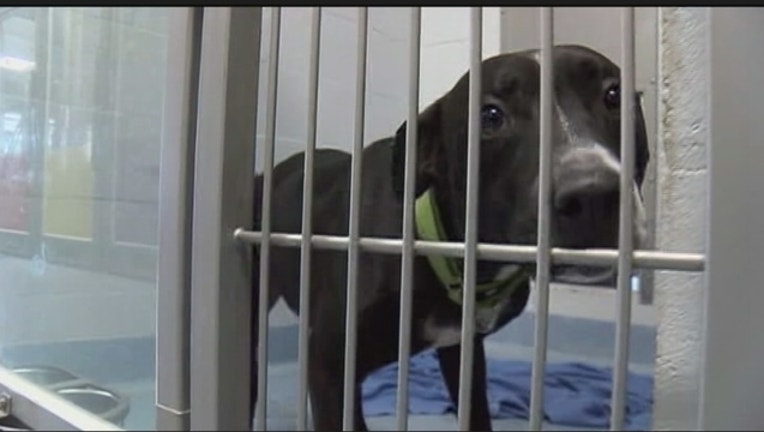Lake County animal shelter works to maintain "no-kill" status

LAKE COUNTY, Fla. (WOFL FOX 35) - For months, a mutt with a swollen eye and salted beard, has been displayed at many adoption events.
The old hound, named Trevor, has been housed at the Lake County Animal Shelter since early 2017 after being lost during a hunting trip.
In shelters all over, finding homes for animals has unfortunately become less of a priority. Lake County, thanks to the shelter's adopted efforts spearheaded by volunteers, is thankfully moving away from this path. They are actually working towards becoming a no-kill community, like the shelters in Jacksonville and Brevard county are.
To be a "no-kill" community, a shelter must save at least 90 percent of the animals that come into the shelter for at least one year and then maintain that statistic.
"It's a local phenomenon in the last year," Lake County Community Safety & Compliance Director Brian Sheahan said. "These animal advocates, all they do is post lost pets on social media."
In just the first couple months of 2017, Lake County has saved 90.8 percent of all animals coming into the shelter, with the aim to euthanize animals only for illness or behavioral problems. If they can maintain this rate for a year, Lake County will earn the "no-kill" distinction. 120 other communities across the country share this honor already, according to Saving90.org.
"What has been accomplished in this short month and a half has been spectacular," Michael Fry, a Minnesota no-kill consultant, told Lake County commissioners recently. He later said that "it's a testament to a healthier society when we are taking care of our homeless pets. It reflects [Lake's] philosophies and morals."
He credits Lake residents for improvements in adoptions, a process he describes as akin to refugee relocation.
"I would argue that animal sheltering and animal control is a crisis-driven industry," said Fry, who suggested shelter changes including moving the surgery room and separating intake for cats and dogs.
In the 12-month period ending Sept. 30, more than 8,000 cats, dogs, horses and pigs came in through the Lake shelter, which has space for about only 200 animals.
Jennifer Ferguson, who sports a tattoo of her dead American bulldog"Bliz" on her bicep, has been part of the effort to save animals in Central Florida for nine years.
"I've seen the best of the best and the worst of the worst," said Lake County Animal Enforcement employee Ferguson.
On a recent Monday morning, Ferguson returned two lost dogs to an ecstatic owner in Eustis. Several months earlier, she was collecting 80 abandoned cats in a Tavares home, where the couch was "saturated with urine" and cats crawled around in the cabinets, she said.
Finding homes for animals is a priority. Since the county's move toward "no-kill," shelter volunteers have almost quadrupled, from 15 to 56.
County Commissioner Leslie Campione said a lot of stakeholders wouldn't participate until Lake went "no-kill."
"I heard so many constituents that wanted to volunteer … [but] didn't want to volunteer because it wasn't a no-kill shelter," said Campione, who has been at the forefront of efforts to make changes at the animal shelter.
About 16 percent of Lake's adoptions come through partnerships with other Lake nonprofits - far above the rest of Central Florida, with Orange County coming in second at 6 percent.
The shelter and nonprofits have had numerous adoption events including a kitten "baby shower" aimed at finding homes for felines. The effort is aimed at "constantly bombarding the public with images of the animals," said Whitney Boylston, executive director of the animal-nonprofit L.E.A.S.H., which stands for Love, Enrichment, Adoption, Shelter, Health.
"We exist to do things that the shelter should not be expected to do on their own, and sometimes that means money," said Boylston, whose nonprofit has paid for animal surgeries and toys.
The effort to maintain 90-percent plus adoption rates hasn't all been smooth - some cases of aggressive dogs up for adoption have been reported.
In February, a couple was interacting with a pit bull mix at the shelter's adoption room when the dog, named Big Man, bit the man's hand and nose. Because the dog had been vaccinated only days before, the man had to be injected with anti-rabies medicine. Another man took home a pit bull mix in February named Heaven from an adoption event. Four days later, it bit him on the arms.
Heaven had been dropped off in December at the shelter by owners who requested euthanasia, saying the dog was attacking their children. Shelter staffers also made several written reports recording Big Man's aggressive behavior.
Sheahan, who oversees the Lake shelter, wouldn't comment on the cases because they are in litigation, but the shelter has changed its rules to inform adopters if the animal has been aggressive or been returned for biting.
Trevor the hound, meanwhile, is no longer at the shelter, where Boylston said "there's always some special sad old dogs."
Trevor was adopted earlier this month.
"It takes a village," she said. "A community can't become no-kill as an island on its own."

